Python

Multi class Classification
We have three classes of images : 7, 8 and 9. The following codes uses VGG16 and CNN to build a model which classifies the images of 7, 8 and 9.
Import necessary libraries as usual
import torchvision
import torch.nn as nn
import torch
import torch.nn.functional as F
from torchvision import transforms,models,datasets
import matplotlib.pyplot as plt
from PIL import Image
import numpy as np
from torch import optim
device = 'cuda' if torch.cuda.is_available() else 'cpu'
import cv2, glob, numpy as np, pandas as pd
import matplotlib.pyplot as plt
from glob import glob
import torchvision.transforms as transforms
from torch.utils.data import DataLoader, Dataset
Load Data: Source of data 7_8_9
train_data_dir = '.../7_8_9/Data/7_8_9/Train'
val_data_dir = '.../7_8_9/Data/7_8_9/Val'Class to load data and make targets
class s_e_n(Dataset):
def __init__(self, folder):
seven = glob(folder+'/7/*.PNG')
eight = glob(folder+'/8/*.PNG')
nine = glob(folder+'/9/*.PNG')
self.fpaths = seven + eight +nine
self.normalize = transforms.Normalize(mean=[0.485, 0.456, 0.406],std=[0.229, 0.224, 0.225])
from random import shuffle, seed; seed(10); shuffle(self.fpaths)
targets = []
for fpath in self.fpaths:
if(fpath.split('/')[-2].startswith('7')):
target = 0
elif ((fpath.split('/')[-2].startswith('8'))):
target = 1
elif ((fpath.split('/')[-2].startswith('9'))):
target = 2
targets.append(target)
self.targets = targets
def __len__(self): return len(self.fpaths)
def __getitem__(self, ix):
f = self.fpaths[ix]
target = self.targets[ix]
#im = (cv2.imread(f)[:,:,::-1])
im = cv2.imread(f)
im = im[:,:,::-1]
im = cv2.resize(im, (224,224))
im = torch.tensor(im/255)
im = im.permute(2,0,1)
im = self.normalize(im)
return im.float().to(device), torch.tensor([target]).to(device)
Load data and display
data = s_e_n(train_data_dir)
im, label = data[2]
plt.imshow(im.permute(1,2,0).cpu())
print(label)
Vgg16 model
def get_model():
model = models.vgg16(pretrained=True)
for param in model.parameters():
param.requires_grad = False
model.avgpool = nn.AdaptiveAvgPool2d(output_size=(1,1))
model.classifier = nn.Sequential(nn.Flatten(),
nn.Linear(512, 128),
nn.ReLU(),
nn.Dropout(0.2),
nn.Linear(128, 3),
nn.Sigmoid())
loss_fn = nn.CrossEntropyLoss()
optimizer = torch.optim.Adam(model.parameters(), lr= 1e-3)
return model.to(device), loss_fn, optimizerSummary of model
#Printing summary of model
from torchsummary import summary
model, loss_fn, optimizer = get_model()
summary(model, input_size=(3, 224, 224))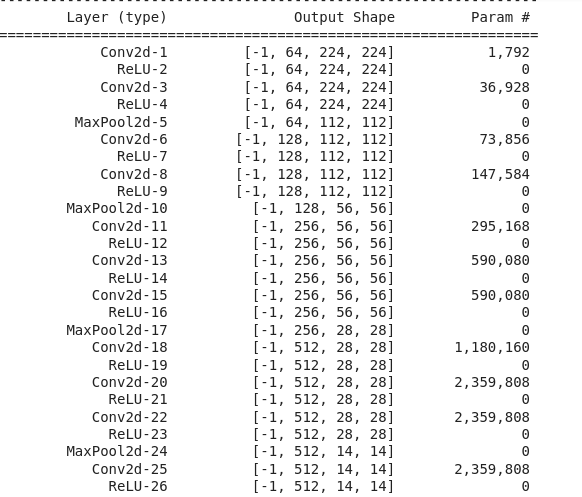
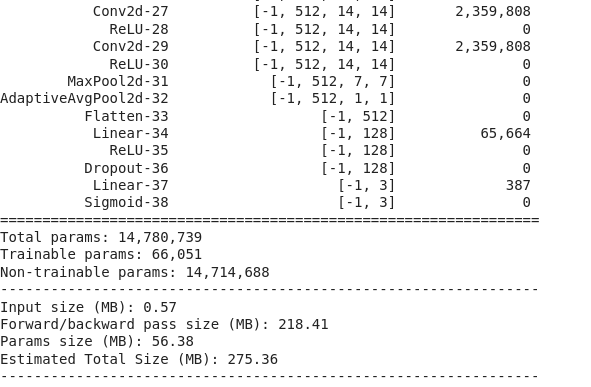
Function to train images per batch, calculate accuracy, load data and calculate validation loss
def train_batch(x, y, model, opt, loss_fn):
model.train()
prediction = model(x)
batch_loss = loss_fn(prediction, y)
batch_loss.backward()
optimizer.step()
optimizer.zero_grad()
return batch_loss.item()
@torch.no_grad()
def accuracy(x, y, model):
z = model(x)
y_hat = torch.max(z.data,1)
is_correct = y_hat[1][0] == label
return is_correct.cpu().numpy().tolist()def get_data():
train = s_e_n(train_data_dir)
trn_dl = DataLoader(train, batch_size=32, shuffle=True, drop_last = True)
val = s_e_n(val_data_dir)
val_dl = DataLoader(val, batch_size=32, shuffle=True, drop_last = True)
return trn_dl, val_dl@torch.no_grad()
def val_loss(x, y, model):
prediction = model(x)
val_loss = loss_fn(prediction, y)
return val_loss.item()Load data and models
trn_dl, val_dl = get_data()
model, loss_fn, optimizer = get_model()Train model up to 10 epochs
train_losses, train_accuracies = [], []
val_losses, val_accuracies = [], []
for epoch in range(10):
print(epoch)
train_epoch_losses, train_epoch_accuracies = [], []
val_epoch_accuracies = []
for ix, batch in enumerate(iter(trn_dl)):
#print(ix)
x, y = batch
#print(y)
#print(y.shape)
y = y.reshape(-1)
#y = y.type(torch.LongTensor)
# print(batch)
batch_loss = train_batch(x, y, model, optimizer, loss_fn)
#print(y)
train_epoch_losses.append(batch_loss)
train_epoch_loss = np.array(train_epoch_losses).mean()
for ix, batch in enumerate(iter(trn_dl)):
x, y = batch
is_correct = accuracy(x, y, model)
train_epoch_accuracies.extend(is_correct)
train_epoch_accuracy = np.mean(train_epoch_accuracies)
for ix, batch in enumerate(iter(val_dl)):
x, y = batch
val_is_correct = accuracy(x, y, model)
val_epoch_accuracies.extend(val_is_correct)
y = y.reshape(-1)
validation_loss = val_loss(x, y, model)
val_epoch_accuracy = np.mean(val_epoch_accuracies)
train_losses.append(train_epoch_loss)
train_accuracies.append(train_epoch_accuracy)
val_losses.append(validation_loss)
val_accuracies.append(val_epoch_accuracy)Plot loss and accuracy
epochs = np.arange(10)+1
import matplotlib.ticker as mtick
import matplotlib.pyplot as plt
import matplotlib.ticker as mticker
%matplotlib inline
plt.rcParams["figure.figsize"] = (10,5)
plt.subplot(211)
plt.plot(epochs, train_losses, 'bo', label='Training loss')
plt.plot(epochs, val_losses, 'r', label='Validation loss')
plt.gca().xaxis.set_major_locator(mticker.MultipleLocator(1))
plt.title('Training and validation loss with CNN')
plt.xlabel('Epochs')
plt.ylabel('Loss')
plt.legend()
plt.grid('off')
plt.show()
plt.subplot(212)
plt.plot(epochs, train_accuracies, 'bo', label='Training accuracy')
plt.plot(epochs, val_accuracies, 'r', label='Validation accuracy')
plt.gca().xaxis.set_major_locator(mticker.MultipleLocator(1))
plt.title('Training and validation accuracy with CNN')
plt.xlabel('Epochs')
plt.ylabel('Accuracy')
plt.gca().set_yticklabels(['{:.0f}%'.format(x*100) for x in plt.gca().get_yticks()])
plt.legend()
plt.grid('off')
plt.show()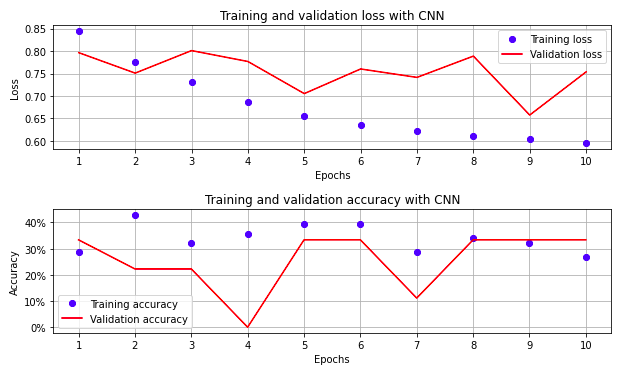
Save model
#save model
model_scripted = torch.jit.script(model) # Export to TorchScript
model_scripted.save('.../789_model_epoch_10_scripted.pt') Load model and test
import torch
device = 'cuda' if torch.cuda.is_available() else 'cpu'
import cv2, glob, numpy as np, pandas as pd
import matplotlib.pyplot as plt
%matplotlib inline
from glob import glob
from google.colab import files
import warnings
warnings.filterwarnings('ignore')
model = torch.jit.load('.../789_model_epoch_10_scripted.pt')
model.eval()Function to predict
def predict(img_file):
im = (cv2.imread(file_name)[:,:,::-1])
im = cv2.resize(im, (224,224))
im = torch.tensor(im/255).permute(2,0,1).to(device).float()
img = im
img = img.view(3,224, 224)
img2 = torch.tensor(img).to(device).float()
img3 = torch.tensor(img2).view(-1,3,224,224)
np_output = model(img3)
print(np_output)
y_hat = torch.max(np_output.data,1)
print(y_hat[1][0])
print(type(y_hat[1][0]))
if((y_hat[1][0])==0):
prediction = 'Seven'
elif ((y_hat[1][0])==1):
prediction = 'Eight'
else:
prediction = 'Nine'
plt.imshow(im.permute(1,2,0).cpu())
return prediction
Load image
uploaded = files.upload()
file_name = uploaded.keys()
file_name = list(file_name)[0]
predict(file_name)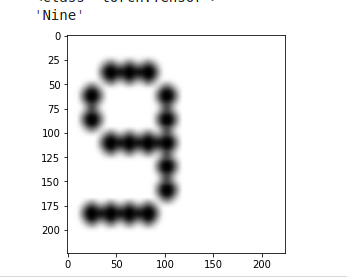
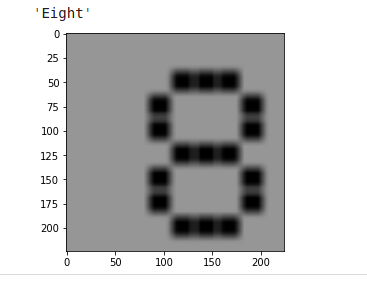
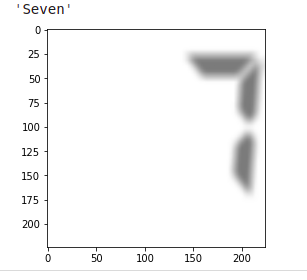
When model got it wrong
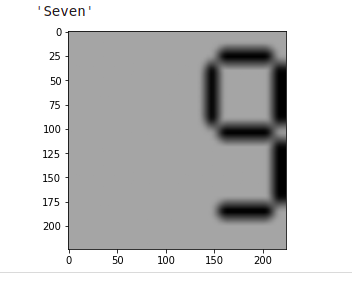
pontu
0
Tags :